Mastering Hydraulic Crimping Tools: A Comprehensive Guide
I. What is a Hydraulic Crimping Tool?
Hydraulic crimping tools are essential workhorses in various industries, ensuring secure and reliable connections in electrical,
mechanical, and hydraulic applications. To harness their full potential, understanding their proper use and maintenance is crucial.
Essential Preparation:
Die Selection: The first step lies in choosing the appropriate dies based on the specific application and material to be crimped.
Refer to the manufacturer's instructions for guidance.
Die Installation:
Install dies in pairs, ensuring correct positioning and alignment within the tool head as per the provided diagrams.
Fully insert and lock the locking bolt to secure the dies in place.

Executing the Crimp:
Material Placement: Position the material to be crimped precisely between the dies in the tool head.
Valve Activation: Turn the rotary valve to the "on" position.
Pressure Buildup: Activate the hand lever repeatedly, raising and lowering it against the fixed hand lever.
This generates hydraulic pressure, forcing the piston outward and compressing the return spring.
Die Engagement: As the dies move closer, exercise caution. Stop the lever action when they lightly touch.
Final Crimp: Verify the correct positioning of the material and perform one final lever action to complete the crimp.
Crimping Completion:
Valve Deactivation: Turn the rotary valve to the "off" position.
Oil Return: Drain the oil into the feed tube to release pressure and enable the lower die to return to its initial position.
Hydraulic crimping tools are used to create a permanent connection between two or more objects, such as wires, cables, or pipes.
They use hydraulic pressure to apply a force to the objects, which creates a strong, secure connection.
II. The key components of a hydraulic crimping tool
Hydraulic Cylinder:
This is the component that generates the hydraulic pressure.
It is typically made of steel or aluminum and is powered by a Hand Pump or an electric motor.
Crimping head:
This is the part of the tool that applies the force to the objects being crimped.
It is typically made of hardened steel and has a die that is specifically designed for the type of connection being made.
Crimping jaws:
These are the parts of the tool that hold the objects being crimped in place.
They are typically made of steel or aluminum and have a gripping surface that is designed to prevent the objects from slipping.
III.Advantages of Hydraulic Crimping Tools
precision and Consistency:
Hydraulic crimping tools provide precise and consistent crimps,
ensuring reliable connections in applications such as electrical wiring and cable assemblies.
High Force Output:
The Hydraulic System enables these tools to exert considerable force,
making them suitable for crimping large conductors and connectors in heavy-duty applications.
Versatility:
Hydraulic crimping tools are versatile and can accommodate a wide range of connectors and conductors,
making them adaptable to different projects and industries.
Time efficiency:
The speed and efficiency of hydraulic crimping tools contribute to time savings,
enhancing overall productivity in various professional settings.
IV. Safety Considerations for Hydraulic Crimping Tools
While hydraulic crimping tools offer numerous benefits, safety remains a top priority.
Operators should adhere to essential safety guidelines to prevent accidents and ensure a secure working environment.
Proper Training:
Operators should undergo thorough training on the use of hydraulic crimping tools,
and understand the equipment's capabilities and limitations.
Regular Inspections:
Regular inspections of the hydraulic crimping tool, including hoses, couplings,
and the crimping head, are crucial to identify and address any potential issues promptly.
Personal Protective Equipment (PPE):
Operators should wear appropriate PPE, including safety gloves and eye protection,
to minimize the risk of injuries during the crimping process.
Follow Manufacturer Guidelines:
Adhering to the manufacturer's guidelines and recommendations for the specific
hydraulic crimping tool model is essential for safe and effective operation.
Why Choose SAIVS™ as Your Supplier?
With 20 years of industry experience, SAIVS is a leading Chinese manufacturer of high-quality tools, offering competitive pricing and excellent customer service.We pride ourselves on exceptional quality control, extensive experience, and comprehensive after-sales service.
